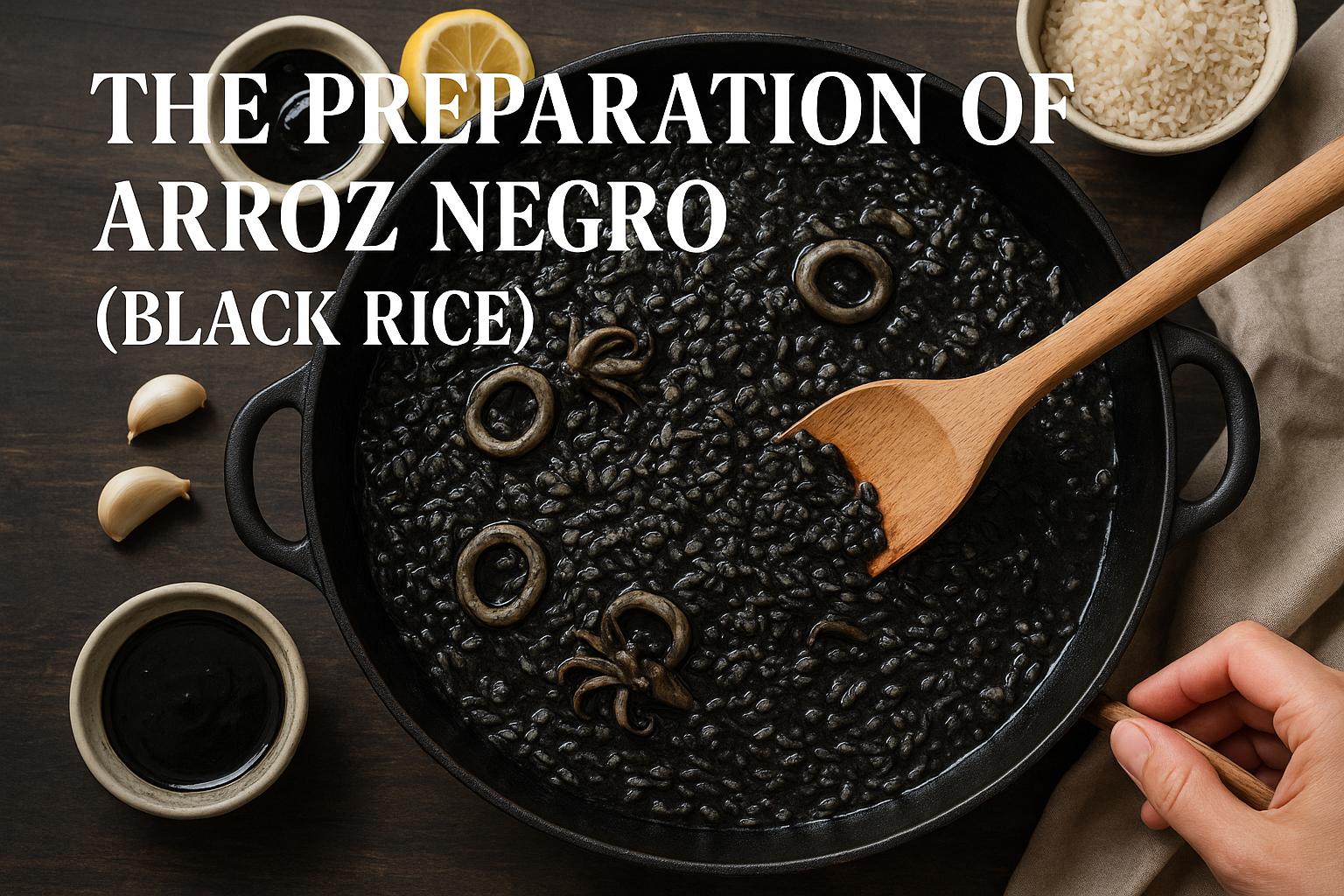
Arroz negro, commonly known as black rice, is a distinctive dish originating from the coastal regions of Spain, particularly Catalonia and Valencia. This dish is celebrated for its deep, dark color and rich flavor profile, both of which are primarily imparted by squid ink (tinta de calamar). This ink, typically extracted from squid or cuttlefish, infuses the dish with a robust seafood flavor that defines its unique culinary identity.
The core components of arroz negro include rice, squid or cuttlefish, onion, garlic, and fish stock. Variations of this dish might also incorporate tomatoes and peppers, which add an additional layer of complexity and depth to the flavor profile. A traditional preparation of arroz negro is typically finished with a garnish of alioli, a garlic mayonnaise-like sauce that contributes a creamy and slightly sharp contrast to the dish.
The central ingredients of arroz negro not only contribute to its distinct appearance but also play vital roles in its flavor and texture:
Squid Ink: This ingredient is paramount in arroz negro. It provides the striking black color and imbues the rice with an unmistakable taste of the sea. It’s integral to achieving the dish’s characteristic umami flavor. While fresh squid ink is ideal for authenticity, pre-packaged squid ink serves as an efficient alternative for home cooks.
Rice: Arroz negro typically employs short-grain rice variants like Bomba or Calasparra. These rice varieties are celebrated for their ability to absorb large amounts of liquid, making them the perfect vehicle for capturing the concentrated seafood flavors without losing their structural integrity.
Seafood: Squid or cuttlefish are not only sources of the ink but also provide meatiness to the dish. Their tender, slightly chewy texture complements the softness of the rice, creating a harmonious blend of consistencies.
Onion and Garlic: These aromatic ingredients form the base sofrito, imparting a sweet and savory foundation that enhances the overall taste profile.
Fish Stock: The use of a well-prepared fish stock introduces a rich, oceanic depth to the dish, allowing the delicate flavors of the rice and other ingredients to shine.
Crafting arroz negro involves several defined steps to ensure that each ingredient contributes to the dish’s final profile effectively:
1. Cooking the Seafood: The process starts with sautéing either squid or cuttlefish in olive oil alongside diced onions and minced garlic. This step is essential for building the base flavors of the dish, creating a harmonious blend that the rice will later soak up. Cooking the seafood until it is translucent ensures that it is tender and releases its flavors into the oil.
2. Introducing Rice: After the seafood and sofrito have melded, the rice is added. It’s crucial to lightly toast the rice in the mixture, allowing it to absorb the flavors and create a base for the squid ink and stock that will follow.
3. Addition of Squid Ink: As the rice gets toasted, squid ink is incorporated to infuse the rice with its iconic black hue and deep sea essence. The aim is a consistent and even distribution across the dish.
4. Simmering with Fish Stock: Gradual addition of fish stock follows, cooking the rice gently while ensuring it absorbs adequate moisture and flavor. It’s essential to stir occasionally to avoid sticking and to promote even cooking.
Rice Selection: Opt for high-quality short-grain rice like Bomba or Calasparra. These types possess a strong liquid absorption capacity which is pivotal for ensuring the rice is flavorful and retains an ideal texture.
Squid Ink Accessibility: While sourcing fresh squid ink can be challenging, many specialty stores provide convenient ready-made packets. These can be used without compromising on taste or visual appeal.
Stock Quality: If possible, prepare a homemade fish stock. This will significantly enhance the dish’s flavor by adding richness and depth that store-bought versions may lack.
Arroz negro richly deserves to be served and enjoyed immediately after preparation to savor its full array of flavors and textures. As this dish comes to the table, it’s common to include a spoonful of alioli on top. The creamy, garlicky contrast this sauce provides perfectly cuts through the savory and intense seafood notes, balancing the dish superbly.
For an enhanced dining experience, consider pairing arroz negro with a crisp, chilled white wine such as Albariño or a light-bodied red wine like a Pinot Noir. These wines complement the seafood flavors and enhance the meal’s overall enjoyment.
For culinary enthusiasts wishing to delve deeper into variations of arroz negro and other Spanish culinary delights, numerous online platforms, cooking blogs, and culinary websites offer both traditional recipes and innovative interpretations. The extensive resources available on these platforms can provide valuable insights and techniques for anyone eager to hone their cooking skills or explore new recipes.
In summary, arroz negro stands out as an exemplary Spanish seafood dish both for its striking visual appeal and its intricate combination of flavors, rooted firmly in the application of squid ink. While grounded in tradition, this dish’s adaptability allows for the introduction of personalized modifications, inviting both new and seasoned cooks to explore its preparation and enjoyment.